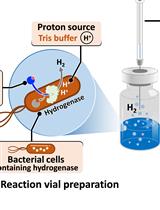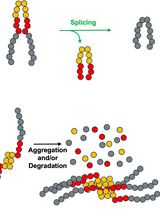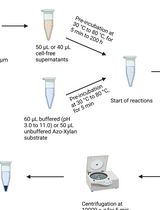- EN - English
- CN - 中文
Design of a Transcription-based Secretion Activity Reporter (TSAR) for the Type III Secretion Apparatus of Shigella flexneri and Uses Thereof
针对弗氏志贺氏菌三型分泌器的一种基于转录分泌活性报告因子 (TSAR)的设计以及其使用
发布: 2014年10月20日第4卷第20期 DOI: 10.21769/BioProtoc.1270 浏览次数: 11208
评审: Kanika GeraAnonymous reviewer(s)
Abstract
Many gram-negative bacterial pathogens, including Shigella flexneri, are able to translocate bacterial proteins, dubbed effectors, across the host cell plasma membrane into the host cell cytosol using a syringe-like structure, the type three secretion apparatus (T3SA). While some bacteria use their T3SA to modulate their phagosomal environment (Salmonella spp.), establish pedestal structure to form microcolonies on the plasma membrane (Enteropathogenic Escherichi coli) or lyse their entry vacuole (Shigella spp.), they all have in common a tightly regulated activity of their T3SA. However, the tracking of the activity of the T3SA in infected cells and tissue has been difficult to perform. Using the property of MxiE-dependent promoters that are upregulated when the T3SA is active, we have recently designed a transcription-based secretion activity reporter (TSAR) that allows the following of the activity of the S. flexneri T3SA in real-time in tissue culture cells and in vivo using fast maturing GFP intrinsic fluorescence. Herein we describe the design of the TSAR and its application to fixed and live samples for microscopy and flow cytometry in a colonic epithelial cell model using TC7 tissue culture cells.
Keywords: Shigella (志贺菌)Background
Materials and Reagents
- Transcription-based secretion activity reporter plasmids (pTSAR1.3, pTSAR1Ud2.1 or pTSAR1Ud2.4s)
Note: Directly available under material transfer agreement (MTA) from Philippe Sansonetti’s laboratory. - Petri dish of Tryptone Casein Soya (TCS) agar (BD Biosciences, catalog number: 236950 ) supplemented with 0.01% Congo red (CR) (SERVA Electrophoresis GmbH, catalog number: 27215.01 ) and the appropriate antibiotic
- TCS Broth (BD Biosciences, catalog number: 211825 )
- Ampicillin (MP Biomedicals, catalog number: 0 219452605 )
- Polylysine (Sigma-Aldrich, catalog number: P1274 )
- Human tissue culture cells such as as colonic epithelial TC7 cells (a clone of Caco-2 cells)
Note: Only polarized epithelial cells permit efficient cell-to-cell spread of Shigella spp. We also recommend using Human cells because it is the sole natural host of Shigella, although most cell lines of other origins tested are also readily infected and could be used for practical reasons. - DMEM (Life Technologies, catalog number: 31885 )
- FCS (Biowest, catalog number: S1810-100 )
- Penicillin/Streptomycin (Life Technologies, catalog number: 15140 )
- Non-essential amino acids (Life Technologies, catalog number: 11140 )
- 0.25% trypsin-EDTA (Life Technologies, catalog number: 25200-056 )
- Fibronectin from human plasma (Sigma-Aldrich, catalog number: F0895 ) (optional)
- HEPES (Life Technologies, catalog number: 15630-056 )
- Gentamicin (Sigma-Aldrich, catalog number: G1397 )
- Cell mask deep red (Life Technologies, catalog number: C10046 )
- Cytochalasin D (Sigma-Aldrich, catalog number: C2873 )
- Live imaging medium containing DMEMgfp-2 (Evrogen, catalog number: MC102)
- PFA (Electron Microscopy Sciences, catalog number: 15714 )
- Glycine (Sigma-Aldrich, catalog number: G7126 )
- Triton X-100 (Sigma-Aldrich, catalog number: T8787 ) (optional)
- Bovine serum albumin (BSA) (Sigma-Aldrich, catalog number: A 9647) (optional)
- Gelatin (Sigma-Aldrich, catalog number: G1393 ) (optional)
- Sodium azide (Sigma-Aldrich, catalog number: 0 8591 ) (optional)
- DAPI stock solution (Sigma-Aldrich, catalog number: D9542 ) (optional)
- MOWIOL (Sigma-Aldrich, catalog number: 81381 )
- 1,4-diazobicyclo-[2,2,2]-octaned (DABCO) (Sigma-Aldrich, catalog number: D27802 )
- Glycerol (VWR International, catalog number: 24388.295 ) alternatively Prolong mounting medium (Life Technologies, catalog number: P36930 )
- 10x phosphate-buffer saline (PBS) (see Recipes)
- PBS/10 µg/ml polylysine (see Recipes)
- DMEM-HEPES (see Recipes)
- Chase medium (see Recipes)
- Live imaging medium (see Recipes)
- PBS/4% PFA (see Recipes)
- PBS/100 mM glycine (see Recipes)
- 5,000x DAPI stock solution (see Recipes)
- Mounting medium (see Recipes)
- Growth medium for TC7 cells (see Recipes)
Equipment
- 35 mm petri dish with glass bottom or 8-wells microplate (Ibidi®, catalog numbers: 81158 and 80826 , respectively) for live microscopy
- 24-well plate
- Coverslips no. 1.5, 12 mm in diameter (Harvard Apparatus, catalog number: 64-0712 )
- Laminar flow hood for cell culture
- Heating water bath
- Tabletop centrifuge for 1.5-2 ml Eppendorf tubes
- Tabletop centrifuge with plate-holding rotor
- CO2 incubator for cell culture
- Tweezers
Procedure
文章信息
版权信息
© 2014 The Authors; exclusive licensee Bio-protocol LLC.
如何引用
Campbell-Valois, F. X., Schnupf, P. and Sansonetti, P. J. (2014). Design of a Transcription-based Secretion Activity Reporter (TSAR) for the Type III Secretion Apparatus of Shigella flexneri and Uses Thereof. Bio-protocol 4(20): e1270. DOI: 10.21769/BioProtoc.1270.
分类
微生物学 > 微生物生物化学 > 蛋白质 > 活性
分子生物学 > 蛋白质 > 表达
细胞生物学 > 细胞成像 > 固定细胞成像
您对这篇实验方法有问题吗?
在此处发布您的问题,我们将邀请本文作者来回答。同时,我们会将您的问题发布到Bio-protocol Exchange,以便寻求社区成员的帮助。
提问指南
+ 问题描述
写下详细的问题描述,包括所有有助于他人回答您问题的信息(例如实验过程、条件和相关图像等)。
Share
Bluesky
X
Copy link















